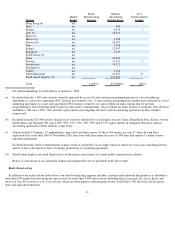iHeartMedia 2004 Annual Report Download - page 20
Download and view the complete annual report
Please find page 20 of the 2004 iHeartMedia annual report below. You can navigate through the pages in the report by either clicking on the pages listed below, or by using the keyword search tool below to find specific information within the annual report.
requirements. The FCC has commissioned a preliminary report on such impact and on the basis of that report, has recommended to Congress
that such requirements be eliminated. We cannot predict the number of LPFM stations that eventually will be authorized to operate or the
impact of such stations on our business.
Other. The FCC has adopted rules on children’s television programming pursuant to the Children’s Television Act of 1990 and rules
requiring closed captioning of television programming. The FCC has also taken steps to implement digital television broadcasting in the U.S.
Furthermore, the 1996 Act contains a number of provisions related to television violence. We cannot predict the effect of the FCC’s present
rules or future actions on our television broadcasting operations.
Finally, Congress and the FCC from time to time consider, and may in the future adopt, new laws, regulations and policies regarding a wide
variety of other matters that could affect, directly or indirectly, the operation and ownership of our broadcast properties. In addition to the
changes and proposed changes noted above, such matters have included, for example, spectrum use fees, political advertising rates, and
potential restrictions on the advertising of certain products such as beer and wine. Other matters that could affect our broadcast properties
include technological innovations and developments generally affecting competition in the mass communications industry, such as direct
broadcast satellite service, the continued establishment of wireless cable systems and low power television stations, “streaming” of audio and
video programming via the Internet, digital television and radio technologies, the establishment of a low power FM radio service, and possible
telephone company participation in the provision of video programming service.
The foregoing is a brief summary of certain provisions of the Communications Act, the 1996 Act, and specific regulations and policies of
the FCC thereunder. This description does not purport to be comprehensive and reference should be made to the Communications Act, the
1996 Act, the FCC’s rules and the public notices and rulings of the FCC for further information concerning the nature and extent of federal
regulation of broadcast stations. Proposals for additional or revised regulations and requirements are pending before and are being considered
by Congress and federal regulatory agencies from time to time. Also, various of the foregoing matters are now, or may become, the subject of
court litigation, and we cannot predict the outcome of any such litigation or its impact on our broadcasting business.
Risk Factors
We Have a Large Amount of Indebtedness
We currently use a portion of our operating income for debt service. Our leverage could make us vulnerable to an increase in interest rates
or a downturn in the operating performance of our businesses or a decline in general economic conditions. At December 31, 2004, we had debt
outstanding of $7.4 billion and shareholders’ equity of $9.5 billion. We may continue to borrow funds to finance capital expenditures, share
repurchases, acquisitions or to refinance debt, as well as for other purposes. Our debt obligations could increase substantially because of
additional share repurchase programs that may be approved by our Board as well as the debt levels of companies that we may acquire in the
future.
Such a large amount of indebtedness could have negative consequences for us, including without limitation:
The failure to comply with the covenants in the agreements governing the terms of our or our subsidiaries’ indebtedness could be an event
of default and could accelerate the payment obligations and, in some cases, could affect other obligations with cross-default and cross-
acceleration provisions.
19
• limitations on our ability to obtain financing in the future;
• much of our cash flow will be dedicated to interest obligations and unavailable for other purposes;
• the high level of indebtedness limits our flexibility to deal with changing economic, business and competitive conditions; and
• the high level of indebtedness could make us more vulnerable to an increase in interest rates, a downturn in our operating
performance or a decline in general economic conditions.
























